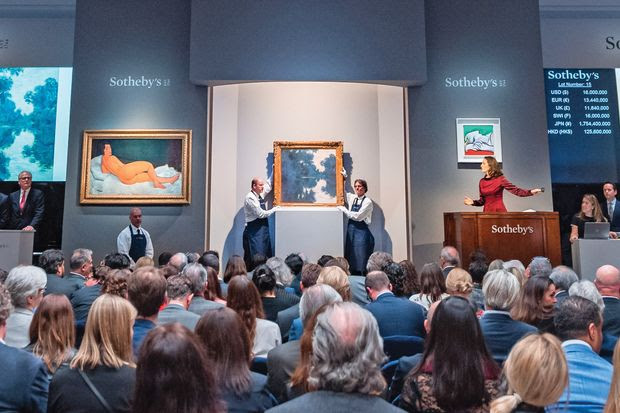정준모
How Art Lovers Squeeze Money From Their Collections

Amedeo Modigliani’s “Nu couché (sur le côté gauche)” achieved US$157.2 million with fees at a Sotheby’s auction in 2018.
Courtesy of Sotheby's
Nearly two years ago at Sotheby’s, auctioneer Helena Newman brought the hammer down when Amedeo Modigliani’s Nu couché (sur le côté gauche), 1917, inched up to US$139 million from a US$125 million opening, after barely a stir of activity in the New York salesroom.
The US$157.2 million total achieved, with fees, meant Modigliani’s painting was the most expensive ever sold at Sotheby’s at the time. The work appeared to have been more or less presold before the auction to a collector who had guaranteed he or she would buy it for an unspecified minimum price.
The buyer of the Italian Modernist’s famous nude remains anonymous, yet there’s a good chance he or she tapped a credit line backed by their own art collection to have the flexibility to fork over so much cash at the drop of a hammer. This isn’t unusual—in the past decade, the business of extending credit backed by art has boomed to an estimated US$21 billion to US$24 billion, according to the 2019 Deloitte Art & Finance Report.
Art lending allows collectors to tap value that’s otherwise “locked up in paintings, sculptures, drawings, photo-graphy, whatever it may be,” says Suzanne Gyorgy, global head, art advisory and finance, at Citi Private Bank’s more than 40-year-old art-advisory and art-finance practice. Banks are comfortable writing these loans because “art has been a very stable form of collateral,” Gyorgy says, even during the 2008 financial crisis.
At that time “some clients considered their art an investment, but not many,” says Evan Beard, national art services executive at Bank of America Private Bank, which began ramping up its art-finance practice only in the past decade, fleshing out a suite of services that includes art lending, art planning, and consignment services.
Today, the private bank has billions of loans outstanding. That’s because many of the active borrowers have a net worth of at least US$100 million, a fact that brings the US$157 million price tag for the Modigliani into focus. By creating a line of credit backed by an art collection, a client can have the “dry powder” to buy anything, Beard says. “We’ve seen musicians and Hollywood producers do an art loan to fund movies.”
Wealth management groups that offer art loans consider their entire relationship with the client, not just the art collateral. When Citi writes a loan, the bank considers their client’s net worth, liquidity, and their cash flow, as well as the quality of the art.
Deloitte estimates private wealth managers account for US$18 billion to US$20 billion of existing art loans. Still, the firm found that 71% of individual private bankers worry about lending against art because of difficulties in assessing risk. Collectors who work with these wary bankers can, however, turn to alternative sources. One is Emigrant Bank, an institution focused on niche assets, which because it’s part of a bank, can offer competitive terms.
Boutique firms that underwrite loans to individual collectors backed only by specific works of art have US$1 billion to US$1.7 billion outstanding. Auction houses finance another US$1.3 billion to US$1.9 billion in loans, Deloitte says.
The benefit of a private bank loan is that the rate is often low, about two percentage points above the London interbank offered rate at Bank of America, for instance. The rate on a loan from a boutique hard-asset lender—meaning the loans are 100% backed by the art—can be more like 7.5%, says Freya Stewart, CEO of art finance at The Fine Art Group in London, a hard-asset lender.
“It’s really fast,” Stewart says. “We can provide several millions of dollars in a matter of weeks.”
FAMILY SITE
copyright © 2012 KIM DALJIN ART RESEARCH AND CONSULTING. All Rights reserved
이 페이지는 서울아트가이드에서 제공됩니다. This page provided by Seoul Art Guide.
다음 브라우져 에서 최적화 되어있습니다. This page optimized for these browsers. over IE 8, Chrome, FireFox, Safari